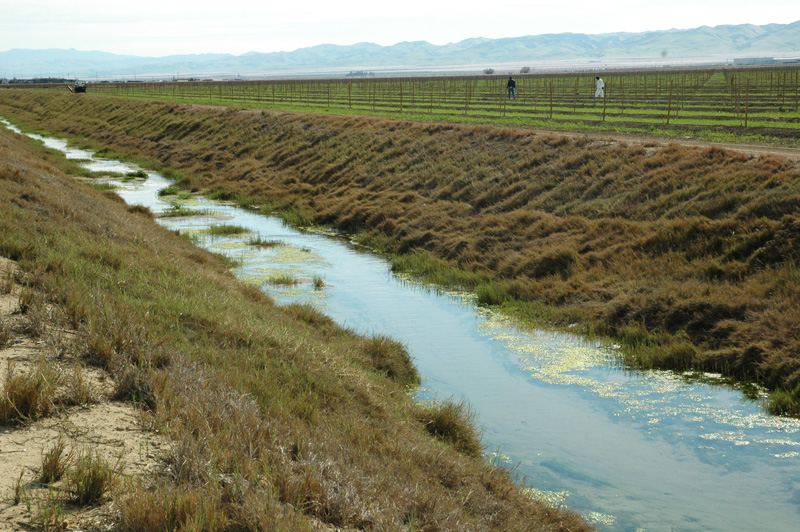
|
| Fig. 1 Drain at Penoche irrigation district, San Joaquin valley, California. |
Professor of Civil and Environmental Engineering
San Diego State University
San Diego, California
[090603]
Victor M. Ponce
ABSTRACT: The minimum amount of runoff that must be preserved in order to maintain basin salt balance is conceptually calculated. The alternative, the anthropogenic conversion of all runoff into evapotranspiration, is unsustainable, because it causes salts to accumulate without limit inside the basin. Nature intended exorheic drainage basins to be in salt balance by means of runoff. Therefore, to preserve this natural service, a limit must be imposed on the consumptive use of runoff through irrigation.
1. INTRODUCTION
Over a measurable period, say one year, the amount of precipitation over a basin is divided into evaporation, evapotranspiration, and runoff. Evaporation (E) is the fraction of precipitation returned to the atmosphere in the absence of vegetation. Evapotranspiration (ET) is the fraction of precipitation returned to the atmosphere through vegetation. In order to avoid confusion, the combined amount of evaporation and evapotranspiration is referred to herein as vaporization (V). Runoff (Q) is the fraction of precipitation returned to the ocean as streamflow.
On a global average basis, vaporization is about two-thirds of precipitation, with runoff constituting the remaining one-third. Therefore, the global average ratio of vaporization to runoff is: V/Q = 2. However, this ratio varies with the climate; in humid regions, it be as low as 1, while in arid regions, it may be 50 and higher.
2. NATURAL SALT PRODUCTION
In a pristine natural environment, the total volume of annual runoff is:
| Ro = Qo A | (1) |
in which
Ro = pristine annual runoff volume, in m3;
Qo = pristine annual runoff depth, in m; and
In Nature, runoff always carries a certain amount of dissolved solids, mostly salts. The salt concentration in runoff is expressed in gr/m3. Thus, the total weight of salt in annual runoff is:
| So = Co Ro | (2) |
in which So = annual amount of salt delivered to the ocean by pristine runoff, in gr; and Co = mean salt concentration in pristine runoff, in gr/m3.
3. EXORHEIC VS ENDORHEIC DRAINAGES
Hydrologic basins can be either exorheic or endorheic, depending on their drainage properties. Exorheic basins have an outlet to the sea; endorheic basins do not. Exorheic basins have finite V/Q ratios, with a global average of 2. On the other hand, in an endorheic basin, runoff is zero; therefore, V/Q = ∞; i.e., all precipitation is being converted to vaporization.
Typically, exorheic basins feature rivers and estuaries, and drain outwards, while endorheic basins feature lakes and wetlands, and drain inwards. However, some apparently closed basins (lakes) may not be fully endorheic, featuring small percentages of runoff, for instance, Lake Titicaca, in Peru (Fig. 2). Therefore, these basins are referred to as semiendorheic. Similarly, some apparently open basins (rivers) may not be fully exorheic, featuring small percentages of forced loss to vaporization (through small lakes), for instance, the saline bogs near Rio Negro, in the Upper Paraguay river basin, Mato Grosso do Sul, Brazil (Fig. 3). Therefore, these basins are referred to as semiexorheic.
Fully exorheic drainages do not accumulate salts and other solids. Semiexorheic and semiendorheic drainages accumulate some salt. Fully endorheic drainages accumulate all the salt that is generated in the basin.
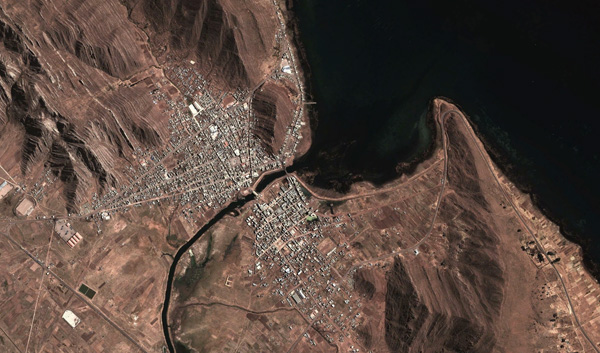
|
| Fig. 2 Outlet of Lake Titicaca at Desaguadero, Puno, Peru. |
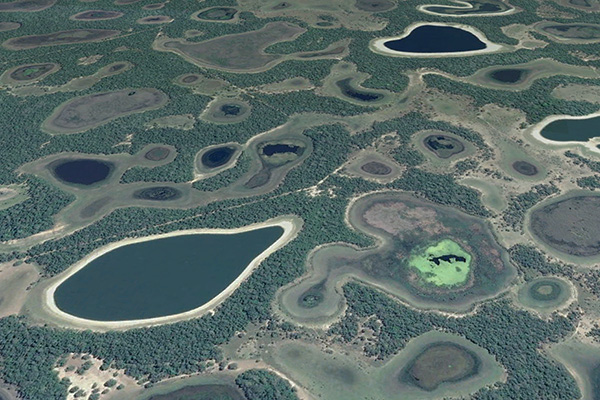
|
| Fig. 3 Saline lagoons near Rio Negro, Mato Grosso do Sul, Brazil. |
4. THE EFFECT OF IRRIGATION ON RUNOFF
Irrigation increases evapotranspiration;
the increase usually comes from a reduction in
runoff.
In the usual setting, irrigation reduces annual runoff to Qa, in which Qa = anthropogenic annual runoff depth, in m. Therefore:
| Ra = Qa A | (3) |
in which Ra = anthropogenic annual runoff volume, in m3.
In addition to a reduction in runoff from Qo to Qa, the amount of salt in runoff may increase from So to Sa, in which Sa is the annual amount of salt delivered to the ocean by antropogenic runoff, in gr. The ratio K, defined as follows:
| K = (Sa - So) / So | (4) |
is an indication of the extent of irrigation development in the basin, including the measure to which effective drainage of irrigation return flows has been implemented. With K = 0, i.e., in the absence of irrigation, or in the absence of return flows, there is no additional export of salts from the basin. With K > 0, there is an additional export of salts. In practice, K is usually greater than zero, because irrigation development promotes new salts, particularly in semiarid and arid regions, besides mobilizing old salts that may have already been in the soil profile due to a previous history of endorheism.
5. THE CONCEPT OF BASIN SALT BALANCE
A basin is said to be in salt balance when there is no significant salt increase (salt accumulation) over the period of analysis, say, one year. A basin in salt balance is an exorheic basin; an endorheic or semiendorheic basin is not in salt balance. Semiexorheic basins are usually not in salt balance.
For a developed exorheic basin to remain in salt balance, the mean salt concentration in anthropogenic runoff should be:
| Ca = Sa / Ra | (5) |
in which Ca = mean salt concentration in anthropogenic runoff, in gr/m3.
With Eq. 4, it follows that
| Ca = (1 + K) So / Ra | (6) |
Therefore:
| Ca Ra = (1 + K) So | (7) |
With Eq. 2, it follows that:
| Ca Ra = (1 + K) Co Ro | (8) |
and with Eqs. 1 and 3:
| Ca Qa = (1 + K) Co Qo | (9) |
from which:
| Qa = (1 + K) Qo / (Ca /Co) | (10) |
For the case of K = 0, i.e., no additional salt export, taken as a first approximation:
| Qa = Qo / (Ca /Co) | (11) |
Equation 11 is particularly significant because it states that anthropogenic runoff is inversely related to the ratio of anthropogenic to pristine mean salt concentrations. In the limit, as Qa → 0, it follows that (Ca /Co) → ∞, i.e., salt accumulates without limit in the basin, defying salt balance.
To achieve basin salt balance, Qa must remain finite; i.e., anthropogenic runoff must remain a finite fraction of pristine runoff. Furthermore, the minimum fraction to reserve for basin salt balance may be calculated by setting the ratio Ca /Co to a workable value determined by consensus of local stakeholders. For instance, if Co = 300 gr/m3, and a value of Ca = 1,500 gr/m3 is deemed to be acceptable, then the anthropogenic-to-pristine mean salt concentration ratio is:
| Ca /Co = 5 | (12) |
and the anthropogenic-to-pristine runoff ratio is:
| Qa /Qo = 0.2 | (13) |
When K > 0, Eq. 10 is applicable. For example, assume K = 0.1 and Ca /Co = 5. Then,
| Qa /Qo = 0.22 | (14) |
Furthermore, assume a high value of additional salt export ratio, K = 0.5, i.e., a highly developed basin. With Ca /Co = 5, Eq. 10 leads to:
| Qa /Qo = 0.3 | (15) |
6. CASE STUDY: TULARE LAKE BASIN, CALIFORNIA
A somewhat extreme case of combined natural/anthropogenic salt sequestration is represented by Tulare Lake basin, in the southern extremity of California's Central valley. Tulare Lake functions as an endorheic basin most of the time, collecting its own local and regional runoff, plus the eventual seasonal overflow from the Kings river, located to the north. However, during extreme periods of local and regional runoff, runoff from Tulare Lake was known to reverse direction and flow northward towards the San Joaquin river valley (Fig. 4). Thus, historically, Tulare Lake had functioned as a semiendorheic basin, with occasional drainage to the north.
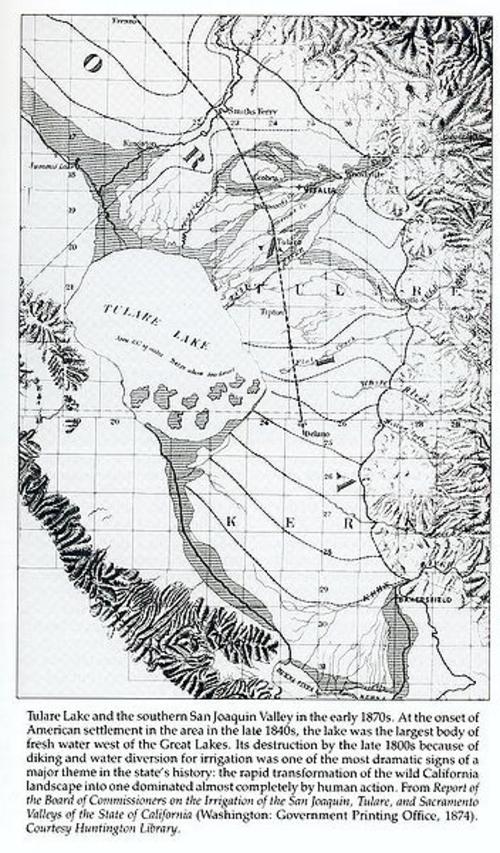
|
| Fig. 4 Tulare Lake basin, California, c. 1874. |
In the past 120 years, irrigation development in Tulare Lake basin has resulted in the conversion of all runoff into vaporization. While the intention (of irrigation) is to convert runoff into evapotranspiration, a significant portion of runoff is actually converted into evaporation (from water-supply ponds and evaporation basins). Consequently, every drop of water that precipitates in the basin is now captured; therefore, not a single iota of salt is allowed to leave.
For the time being, the irrigation system works because the drainage system carries the salt brine away from the root zone, handles it and accumulates it in evaporation ponds (Fig. 5). As the system continues to operate, the need for additional evaporation basins becomes apparent. However, it is clear that the system is unsustainable, carrying with it the certainty of its eventual demise.
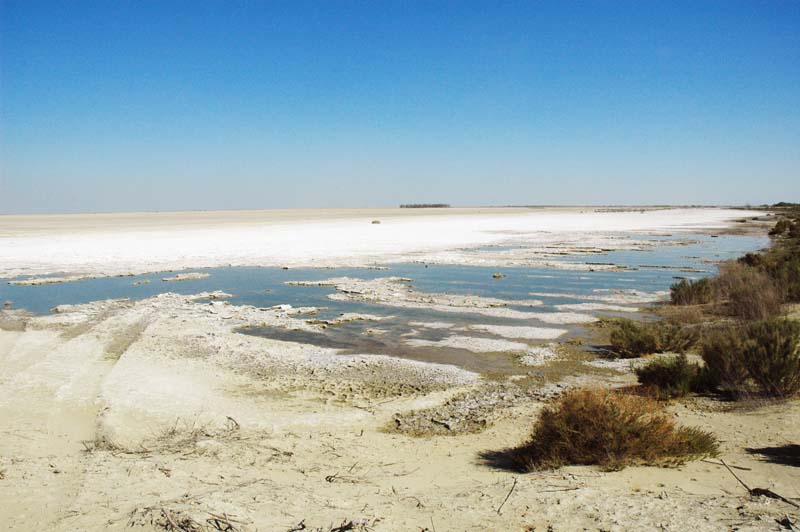
|
| Fig. 5 Evaporation pond in Tulare Lake basin, Tulare County, California. |
7. CONCLUDING REMARKS
The conceptual analysis formulated herein demonstrates that a minimum anthropogenic-to-pristine runoff ratio must be preserved in irrigation development if a basin is to achieve some measure of salt balance. There can be no salt balance if the anthropogenic-to-pristine runoff ratio is zero, i.e., if all the pristine runoff is converted to vaporization.
There is a maximum limit to the amount of runoff that can be appropriated for consumptive uses. Disregarding this limit leads to a loss of basin salt balance, a practice which is unsustainable. Thus, regulation of basin water quantity is absolutely necessary to preserve land quality. In other words, the preservation of water quality must not be achieved at the expense of the degradation of land quality.
NOTATION
A = basin drainage area (m2);
Ca = mean salt concentration in anthropogenic runoff (gr/m3);
Co = mean salt concentration in pristine runoff (gr/m3);
E = evaporation (m);
ET = evapotranspiration (m);
K = ratio of excess salts due to irrigation, delivered to the oceans, to salts delivered to the ocean by pristine runoff, Eq. 4;
Q = runoff (m);
Qa = anthropogenic annual runoff (m);
Qo = pristine annual runoff (m);
Ra = anthropogenic annual runoff (m3);
Ro = pristine annual runoff, (m3);
Sa = annual amount of salt delivered to the ocean by anthropogenic runoff (gr);
So = annual amount of salt delivered to the ocean by pristine runoff (gr); and
V = vaporization, defined as the sum of evaporation and evapotranspiration (m).